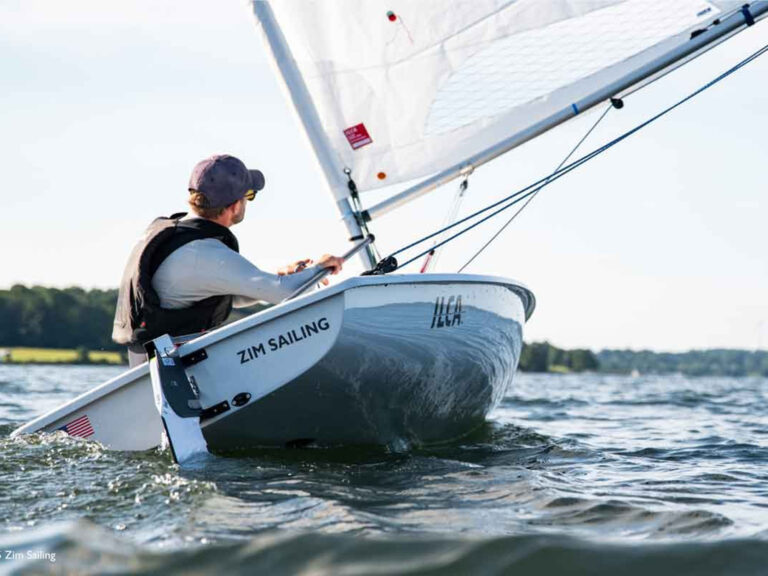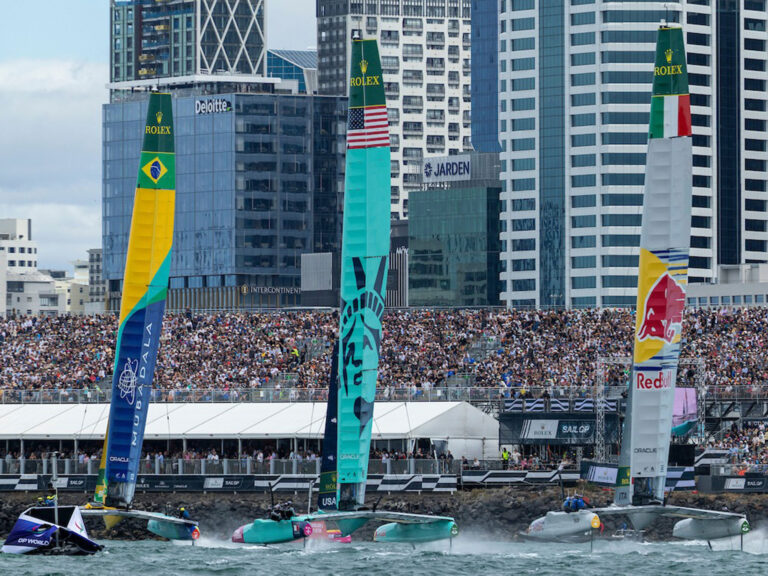
FirstBeatKipStoneSt
In mid-November, Kip Stone became the first American sailor to win his class in the Route du Rhum, a singlehanded race from St. Malo, France to Guadeloupe. In doing so, Stone broke the class record for the 3,500-mile course by over 18 hours, finishing in 17d:22h:36m. However, Stone says the race, his second solo competition across the Atlantic, didn’t feel much like a record-breaking run. He rarely, if ever, saw the expected trade winds and spent a lot of time bobbing around in little or no breeze. A sudden front on Day 10 shredded one of his headsails, but it was the constant pressure applied by the 25-year-old Frenchwoman Servane Escoffier that provided the most excitement. After building a big lead early in the race, Stone, 45, watched Escoffier chip away at his advantage until she was, at one point, theoretically in the lead. But Stone was able to prevail down the stretch. When we spoke with Stone a few days after his finish, he was already back at work at his screen-printing company Artforms, but dreaming of his next solo adventure.Congratulations on the win. Were you surprised at all by your performance?I was labeled the overwhelming favorite, so in some ways I had everything to lose and nothing to win. In the end, of course, to finish first, first you’ve got to finish. To go 3,500 miles and keep the thing together and push hard, it’s an accomplishment. I’m pleased and I’m happy it’s over; it was a long and hard race.For the 60-foot tris and the Open 60 monohulls, especially the leaders, it was a quick race. But that wasn’t the case for your class, was it?The times for the tris and the Open 60s were stunning. I think it’s fair to say that the further back you were in the race, the worse the winds were. I would characterize this last trip across the Atlantic as very soft. I spent days bobbing around, working hard to make the boat go 1, 2, 3 knots, and very little time at speed-15, 16, 17, 18 knots. On a trip of that length you’d expect more of that. You look at the 40s that finished behind me by days and days. It’s not representative of the relative speeds of the boats.That low speed stuff is sometimes more taxing than the gnarly conditions…For me it is. I like going fast. Sitting around, really just trying to keep the boat inching along, it’s so hard. The pilots don’t work, there’s almost more noise with the boat just rocking around in the middle of the ocean. After a time, it’s just maddening. I had a lot of that, a lot more than I would’ve ever expected. I didn’t see one hour of trade winds the whole trip. Imagine sailing from Europe to the Caribbean without the trade winds. That’s what that race was about.Enough to make people go crazy. But then most people think you’re already crazy.I’m just barely hanging on to my sanity.Being labeled the favorite. Is than an indication of how far you’ve come in this sport over the past few years?I certainly have put my time in the boat. I think I’m close to 50,000 miles now. I don’t know if the word made it out. Most of my time is spent in the office trying to earn money to keep the boat going. So when the last minute they told me I needed to do a 500-mile qualifier, I dropped my crew off in Halifax and sailed solo to the start of the race. I had three solo transatlantics in me before the start of the race. Like any boat, time in the boat is a huge advantage. On top of that I’ve got a very fast boat.You mention the boat. How close are you to maximizing the potential of Artforms?I think for myself personally, sort of the rule of thumb in Open-class sailing is that it’s 50 percent boat and 50 percent sailor. I’d say for me, I keep learning things, but my curve is flattening out. The boat, like any Open-class boat, you can keep throwing money at it and make is faster. I’m self-sponsored so there’s only so much of that I can do. It’s a miracle I’ve got as far as I’ve gotten. There’s room for improvement for sure. Another couple of percent, easy.After this win, your third big win, are you starting to get any interest from sponsors?I’d love to hear from anybody who’s remotely interested in sponsoring this effort. I feel like I’ve learned how to play the game. I’m ready to take the next step up into the 60s. Artforms is for sale. I’m trying to find the person for whom this boat becomes the next opportunity.It seems like the 50-foot class provides a great learning platform.I think so. Certainly for me that’s been my experience. It’s a mini 60. It’s a little bit more forgiving and it’s a lot less expensive but it still lets you get out there and put the pedal down and have the experience of sailing the boat fast offshore.It’s a packed schedule for solo sailors over the next few years. What are your plans?Right now, I’m back in my office, trying to build my business to a level where I could consider campaigning a bigger boat. But it’s a big jump from an Open 50 to an Open 60. In the meantime I’m hopeful that I can find some people or corporations that want to help me shortcut the process. For me, it’s starting to feel like the end of my first ride on this boat. Now of course, if nobody steps up and goes after the records I’ve set, the Bermuda One-Two is coming up again. The Transat Jacques Vabre is just around the corner. Transat is only 18 months away. Those are all super great races. If things were to work out, are you looking at the Barcelona World Race, or the Vendee Globe?I dream about doing those races. But it’s still a jump for me. To get from a 50 to a 60 is a big jump financially. I’ve got a team in place that’s ready to go. I feel like I’ve learned to play the game. I’m gung-ho, so it’s really just a matter of trying to figure out how to make it happen.Take us back to the race you just finished. You got out to an early lead, but it got quite close at the end. What happened?Servane Escoffier, she was doing everything right. I had a nice solid lead most of the race, but she just kept hitting the corners and forcing me to go out to cover her. Even if the corner was looking good, if she didn’t follow me out there, I’d get stuffed. I ended up taking sort of what you’d consider a middle route and as she went out to the corners, I just tried to cover her out there. In the end, I beat her by a little over a day. But the race was much closer. A day out, it was a six-hour race, and we were in two different systems. Hour by hour my lead when from 150, 140, right down to 50 or 60 miles. I got into her breeze, jibed first, and snuck in on a dying breeze, while she got left out there for a day.Were you relatively confident things would work out your way?I was working hard. I don’t take anything for granted out there. I was not resting. For a while there the routing programs showed her finishing ahead of me. So that will certainly light the fire.It’s nice those computers aren’t always right.Thank goodness for that.For more on Stone, including dispatches from his Route du Rhum experience, check out www.kipstone.com





